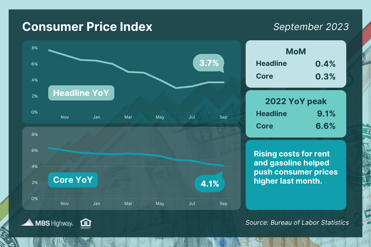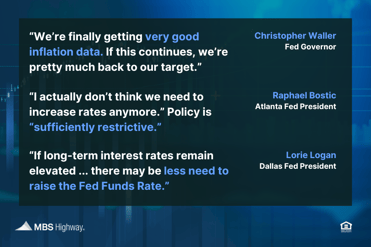Fed Members Breaking Rank on Rate Hikes?

Shelter and energy costs pushed consumer prices higher in September, but inflation has made significant progress lower since peaking last year – and some Fed members are taking notice. Here are last week’s headlines:
- Lodging, Energy Costs Push Inflation Higher
- Wholesale Inflation Heating Up
- Fed Members Breaking Rank on Rate Hikes?
- Understanding Seasonal Housing and Appreciation Trends
- Initial Jobless Claims Remain Tame
Lodging, Energy Costs Push Inflation Higher

September’s Consumer Price Index (CPI) showed that inflation rose 0.4%, with this monthly reading coming in just above estimates. On an annual basis, CPI held steady at 3.7% last month, though this is still near the lowest level in more than two years. Core CPI, which strips out volatile food and energy prices, increased 0.3% while the annual reading declined from 4.3% to 4.1%.
Rising shelter, energy and gasoline prices helped push inflation higher last month. However, oil prices have fallen since the end of September, which should help inflation moving forward if they don’t spike higher again.
What’s the bottom line? Inflation has made significant progress lower after peaking last year, with the headline reading at 3.7% (down from 9.1%) and the core reading at 4.1% (down from 6.6%). Remember, the Fed has been hiking its benchmark Fed Funds Rate (which is the overnight borrowing rate for banks) to try to slow the economy and curb inflation.
Their latest hike in July was the eleventh since March of last year, pushing the Fed Funds Rate to the highest level in 22 years. The Fed did not hike at their September meeting, so they could continue to assess incoming inflation, labor sector and other economic data.
Will the progress on inflation be enough for another pause at their November 1 meeting?
Wholesale Inflation Heating Up
The Producer Price Index (PPI), which measures inflation on the wholesale level, increased by 0.5% in September, coming in hotter than expected. On an annual basis, PPI rose from 2% to 2.2% though there was a big revision to the previous report, bringing the annual figure up from 1.6% to 2%.
Core PPI, which also strips out volatile food and energy prices, rose by 0.3%, with the year-over-year reading increasing from 2.5% to 2.7%. There was also a big revision to this data in the previous report, moving this annual figure up from 2.2% to 2.5%.
What’s the bottom line? While annual PPI moved higher in the wrong direction, it remains well below last year’s 11.7% peak. Plus, much of the increase in wholesale inflation was also due to rising energy prices, which were up 3.3% last month after rising 10.3% in August.
Fed Members Breaking Rank on Rate Hikes?

Earlier this month, Fed Governor Michelle Bowman expressed concern about high inflation, stating that she expects the Fed may need to “raise rates further and hold them at a restrictive level for some time.”
However, other Fed members have signaled that they may be ready to end hikes to the Fed Funds Rate, citing the risks of hiking too much. Fed Governor Christopher Waller said, “The financial markets are tightening up and they are going to do some of the work for us.” He added, “We’re finally getting very good inflation data. If this continues, we’re pretty much back to our target.”
Atlanta Fed President, Raphael Bostic, further stated, “I actually don’t think we need to increase rates anymore,” as he noted that rates were “clearly” restrictive and slowing the economy. San Francisco Fed President Mary Daly has also noted the need for further hikes “is diminished” if financial conditions remain tight. Dallas Fed President Lorie Logan and Philadelphia Fed President Patrick Harker have made similar comments as well.
What’s the bottom line? We are clearly seeing some dissent among Fed members, which will be crucial to follow ahead of their next rate decision on November 1.
Understanding Seasonal Housing and Appreciation Trends
Zillow reported that home values declined by 0.1% in September, the first monthly decrease since February, though prices are still 2.1% higher than in September of last year. In addition, home values are still on pace to increase 6% this year according to Zillow’s index.
What’s the bottom line? The small price decline in September follows significant increases seen throughout the spring and summer months, including a 1.3% rise in April, May and June and a 0.7% rise in July. Fall usually brings less competition in the housing market because families with school-age children like to be settled ahead of a new school year. This season is typically the softest for home price appreciation.
Initial Jobless Claims Remain Tame
Initial Jobless Claims were unchanged in the latest week, with 209,000 people filing for unemployment benefits for the first time. This is the fourth straight week that Initial Claims have been below 210,000, remaining near an eight-month low and suggesting that employers are holding on to workers.
Continuing Claims rose by 30,000, with 1.702 million people still receiving benefits after filing their initial claim. This data has moved higher over the last few weeks, and we’ll have to see if this trend continues as some companies have reduced hiring plans.
